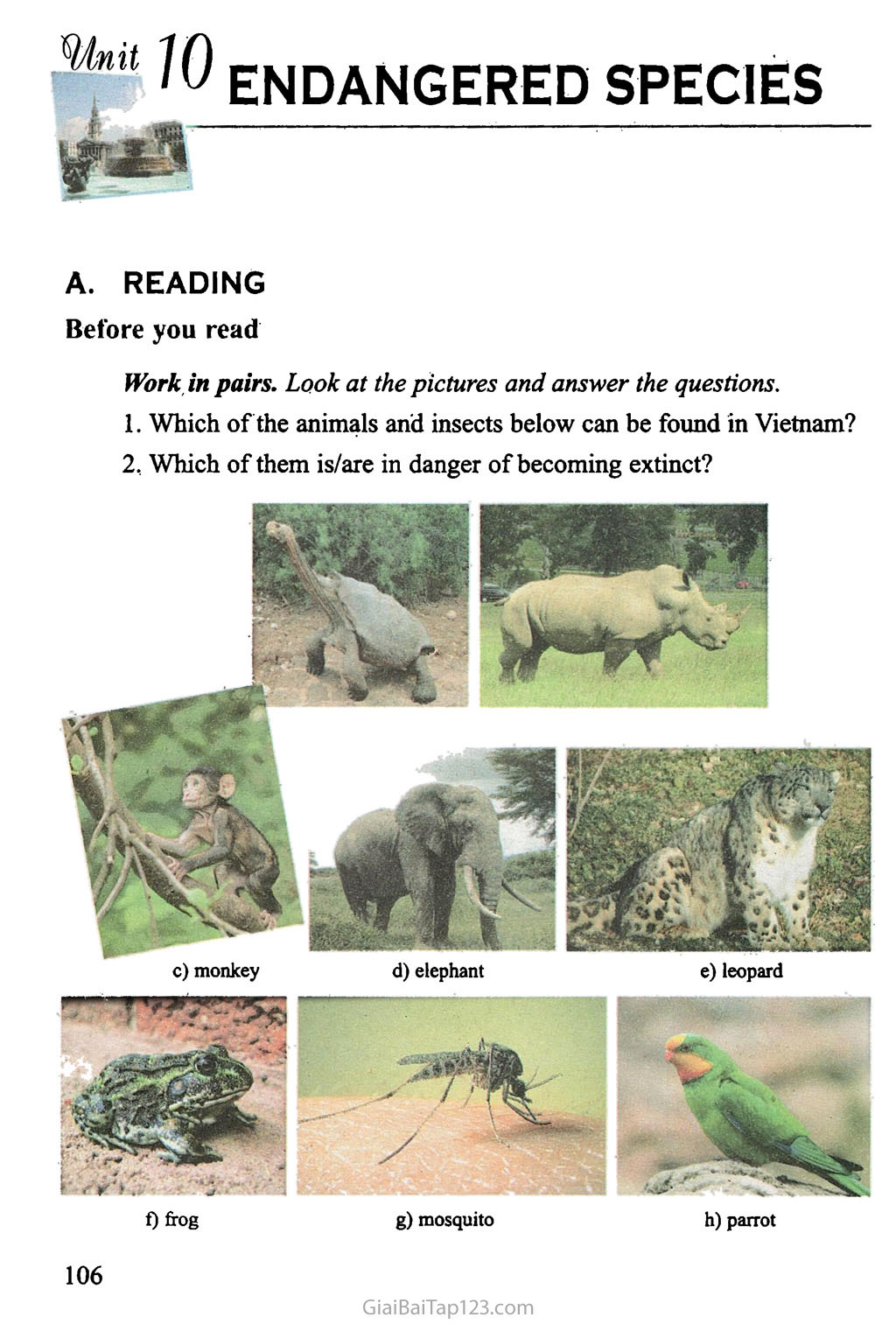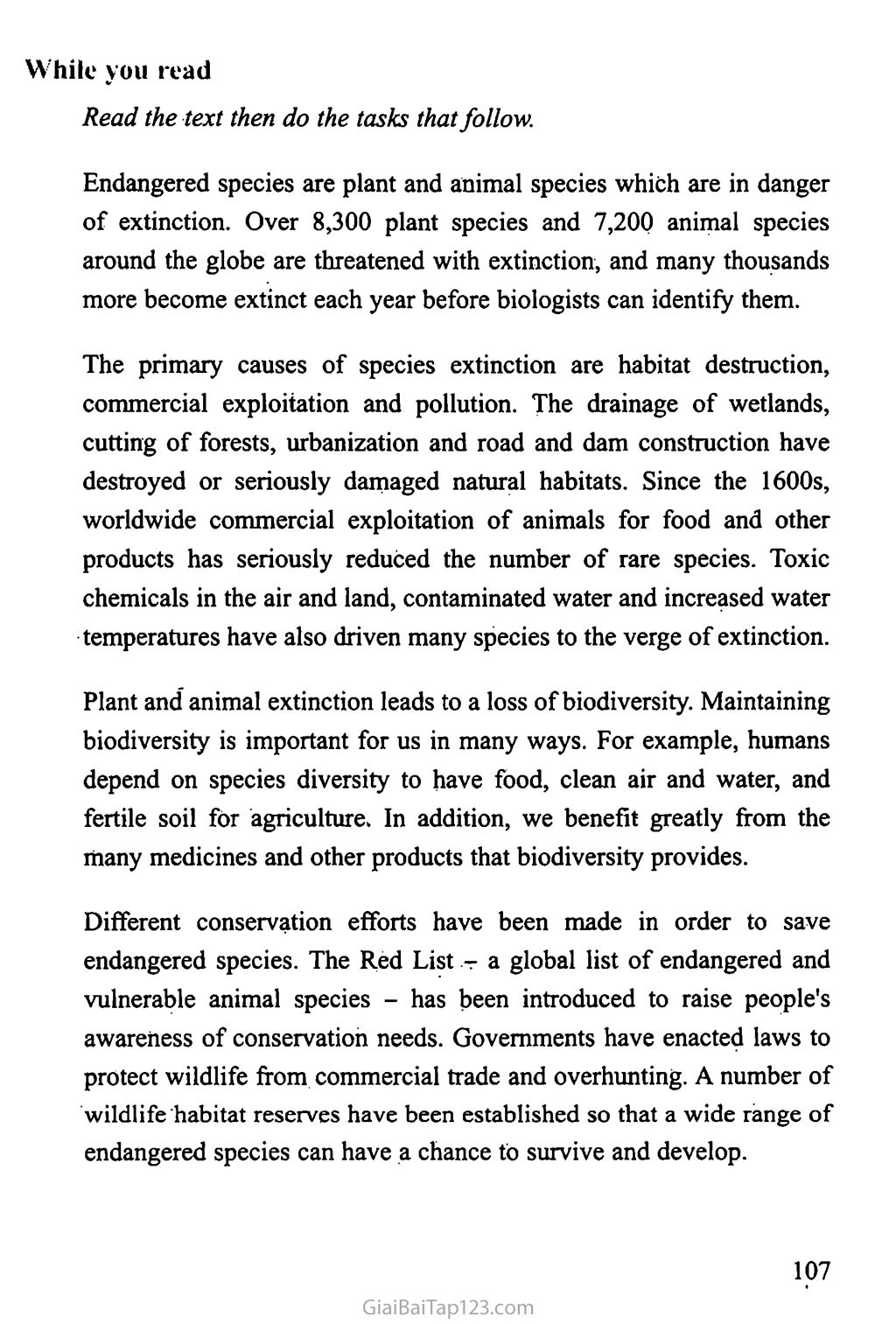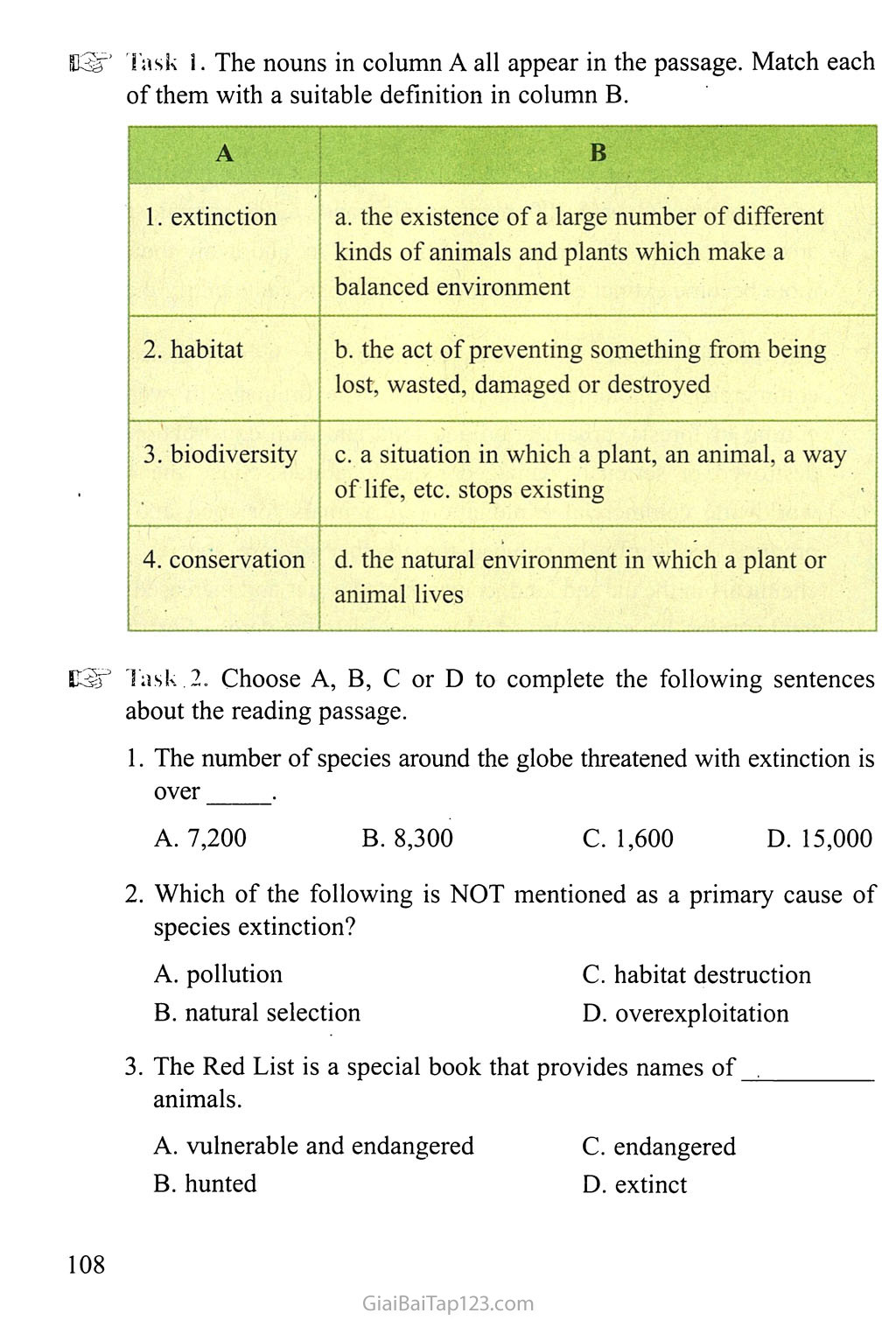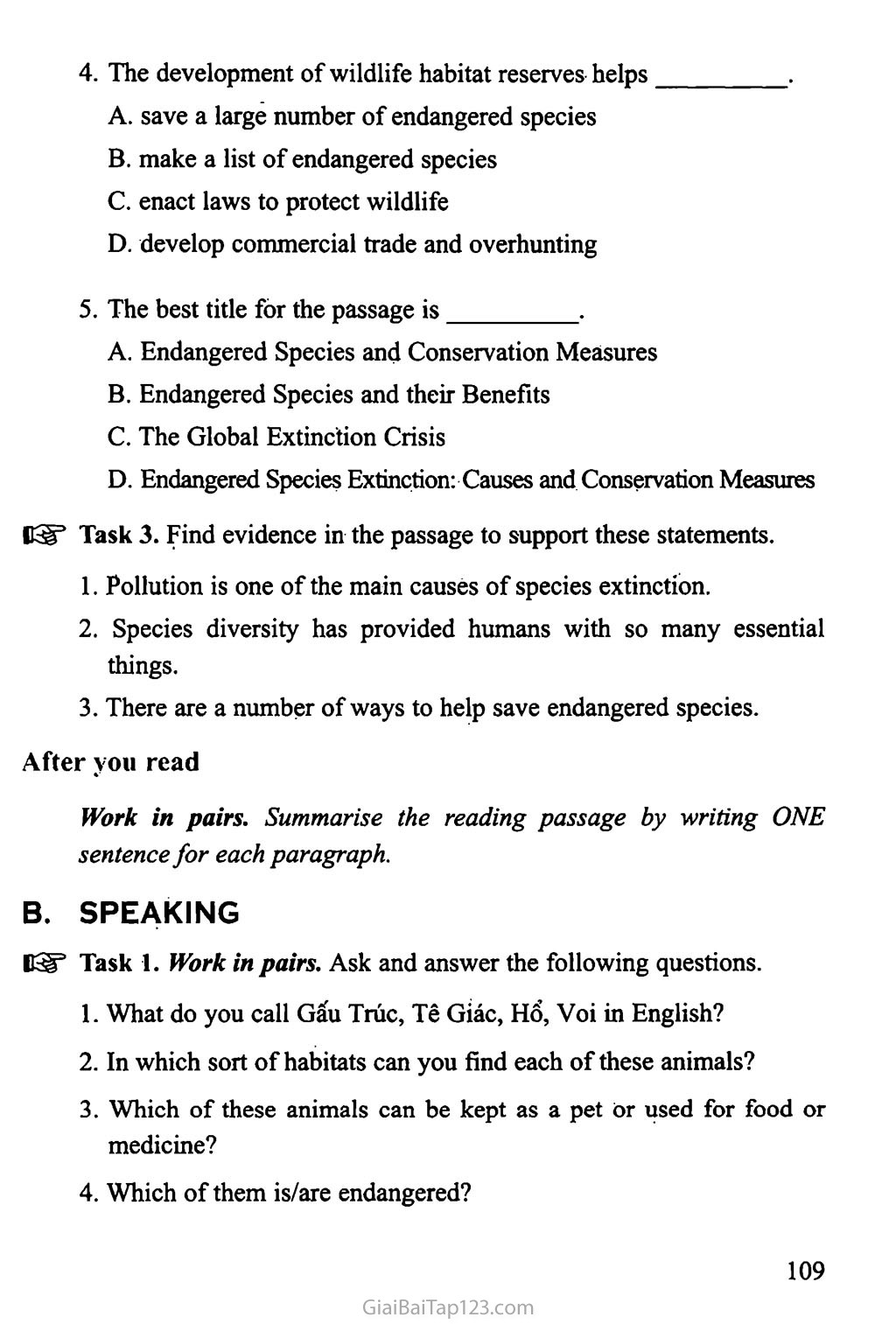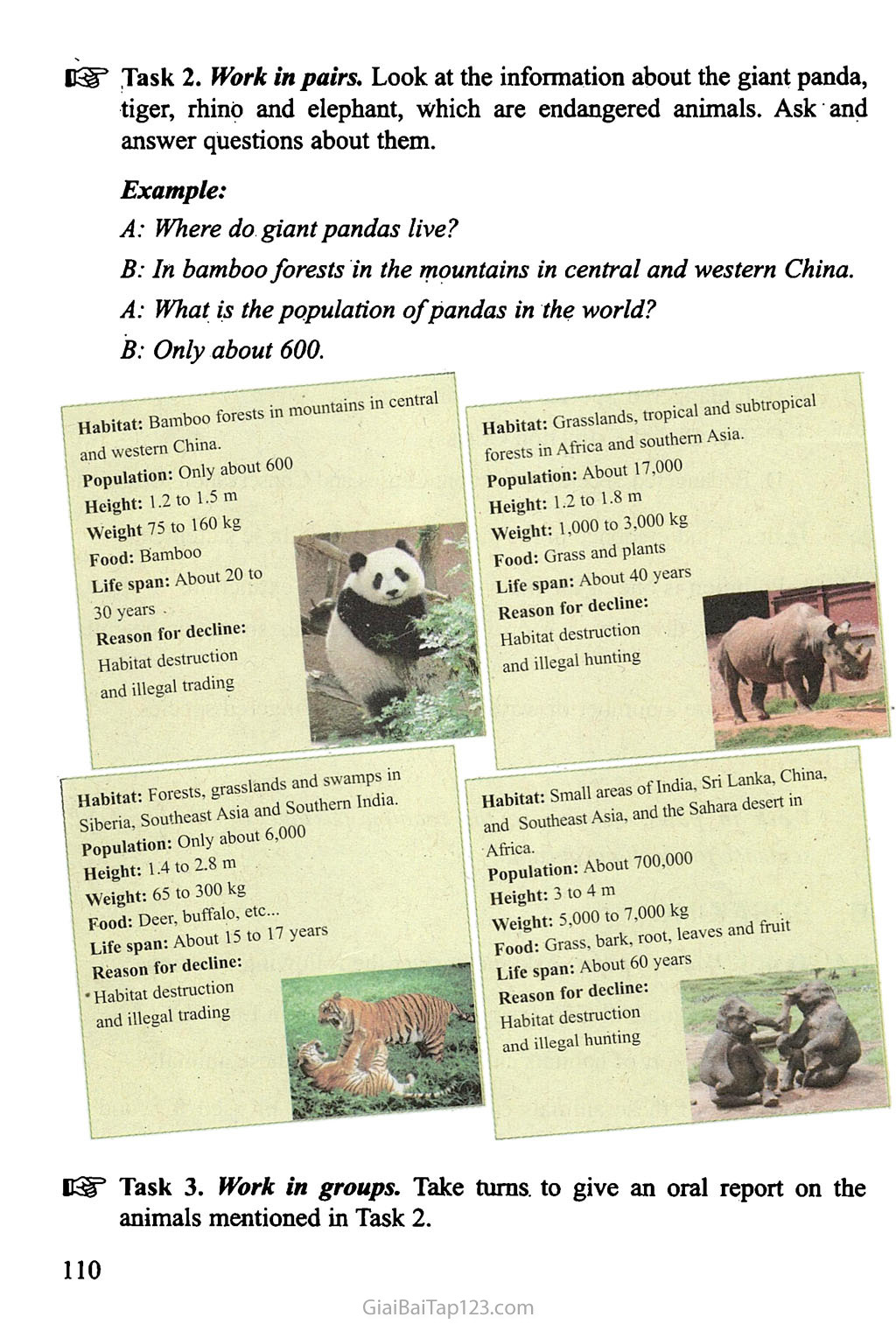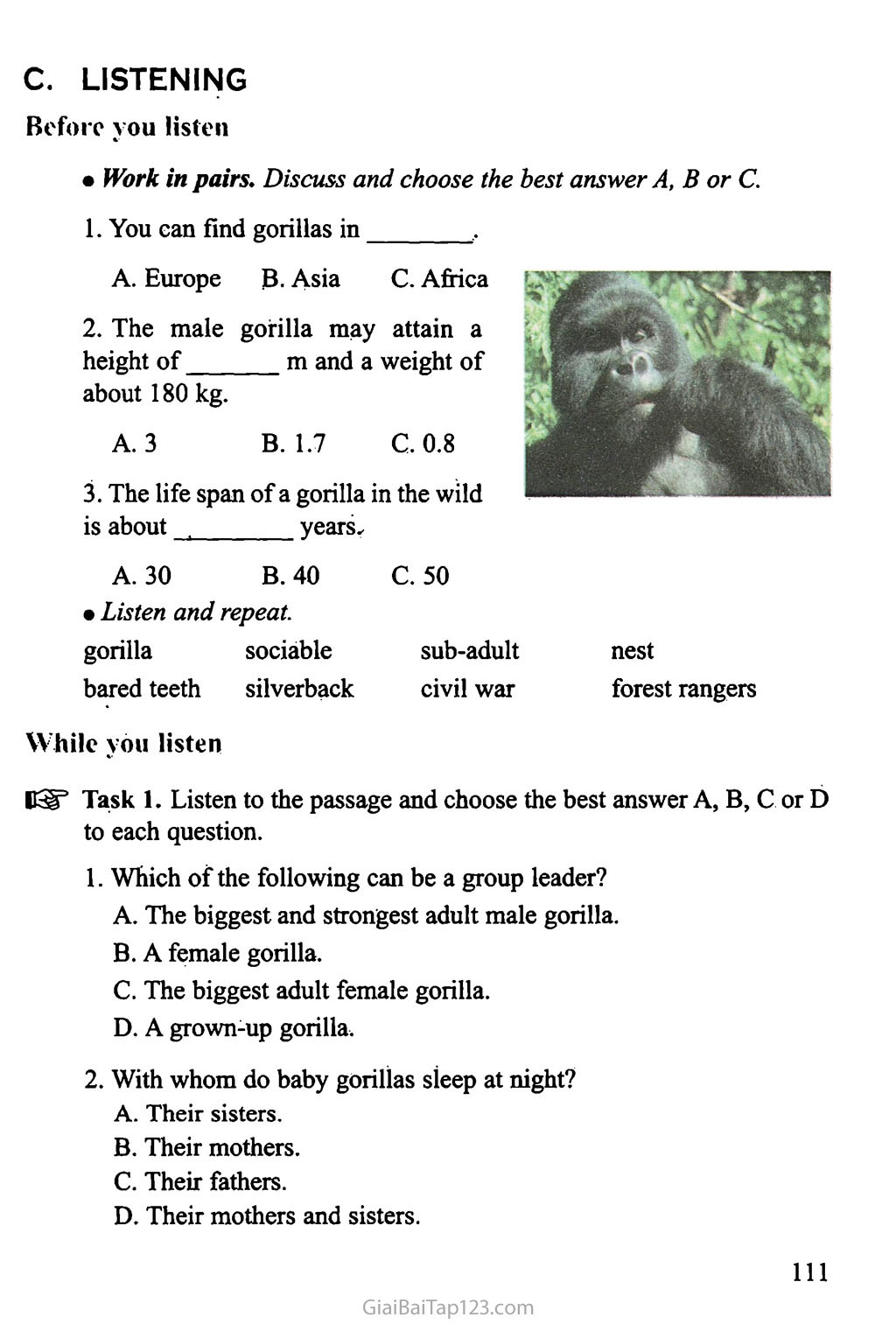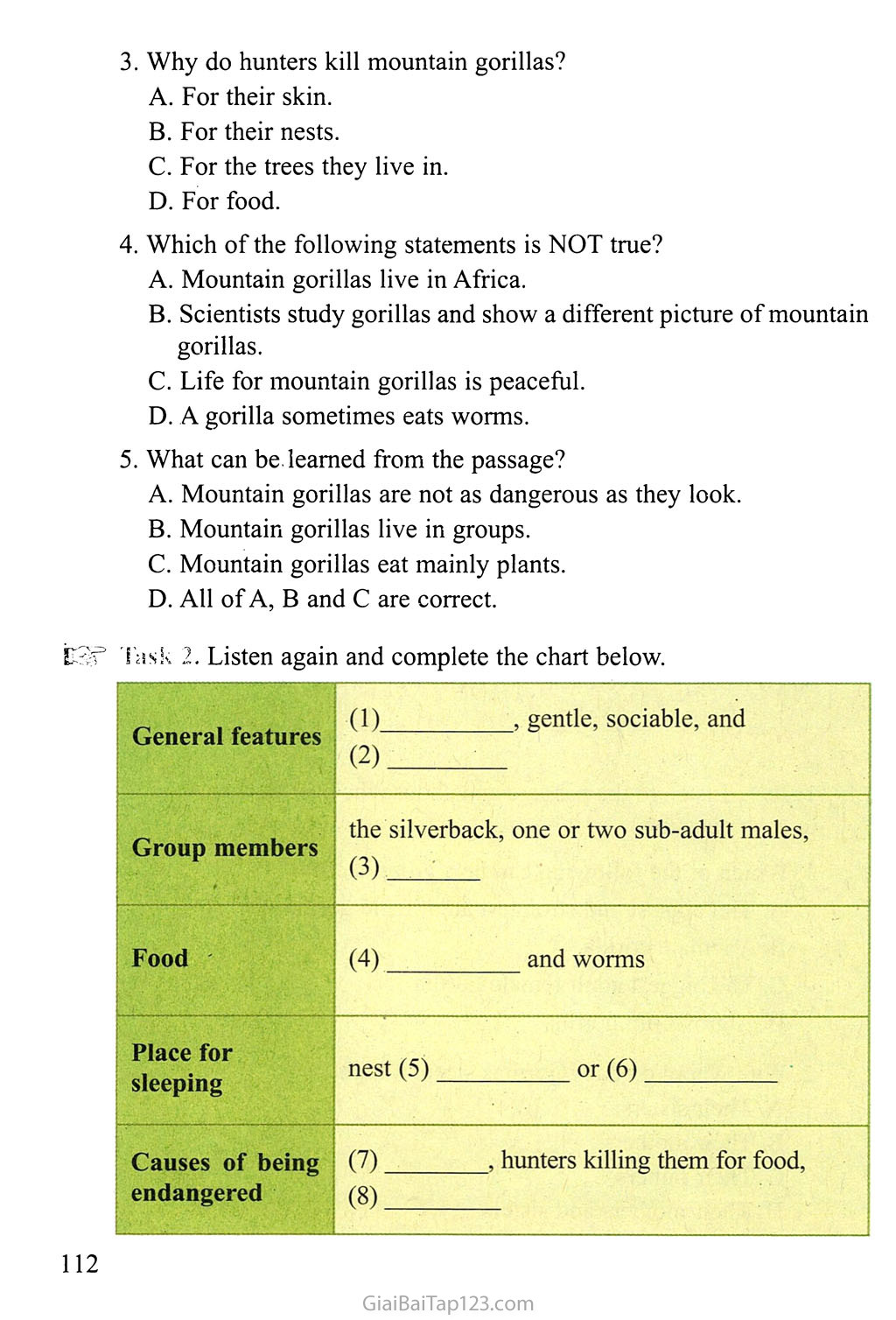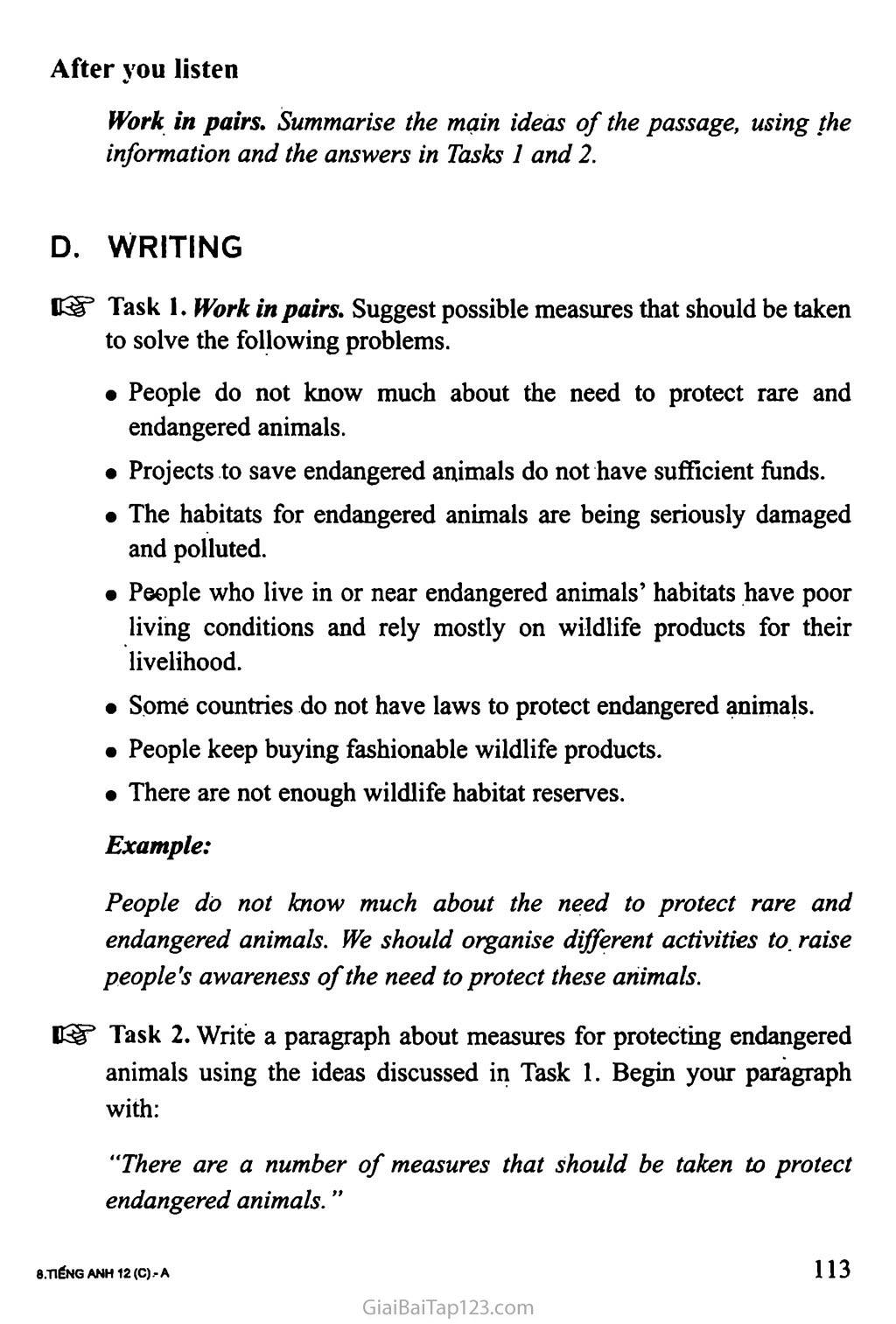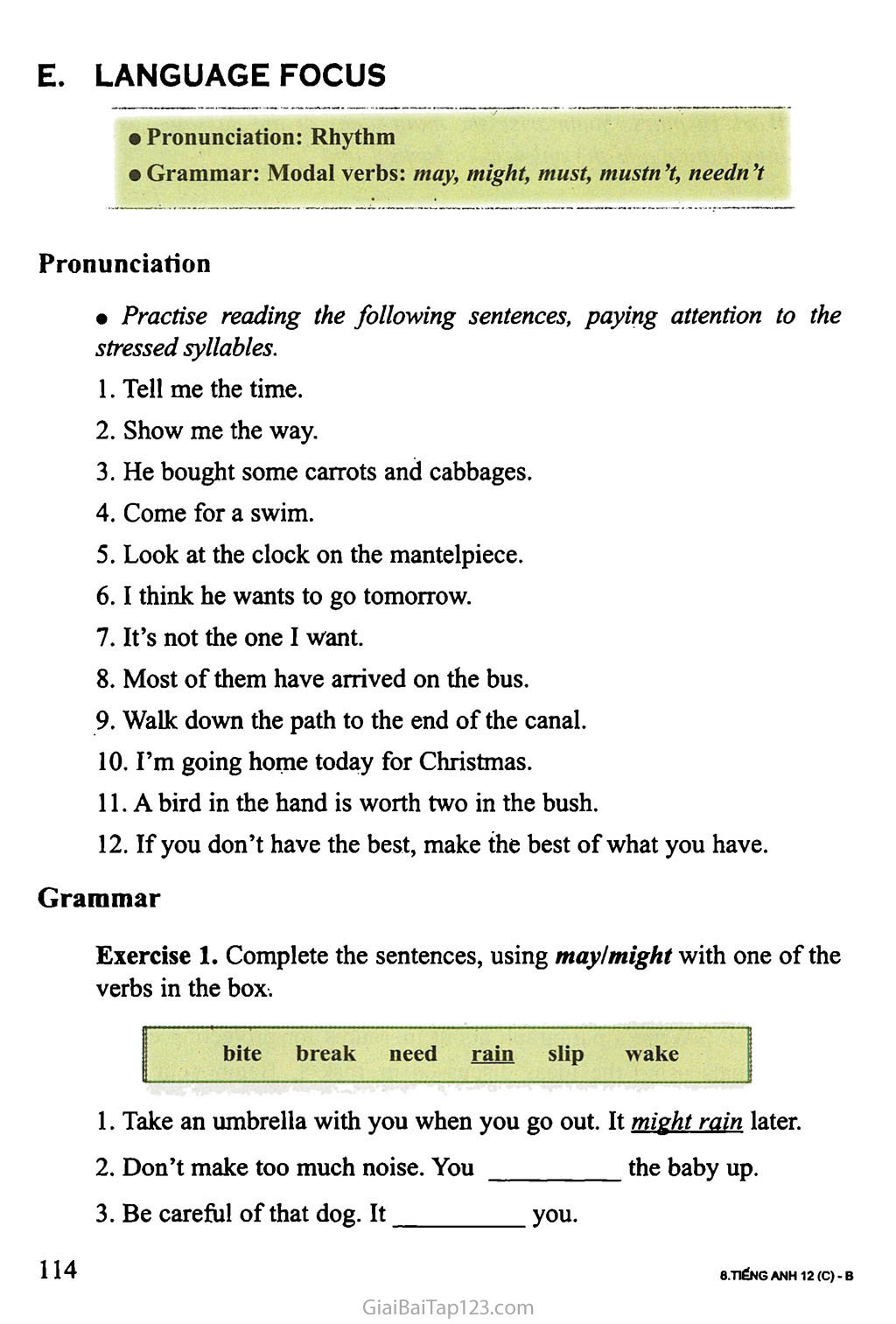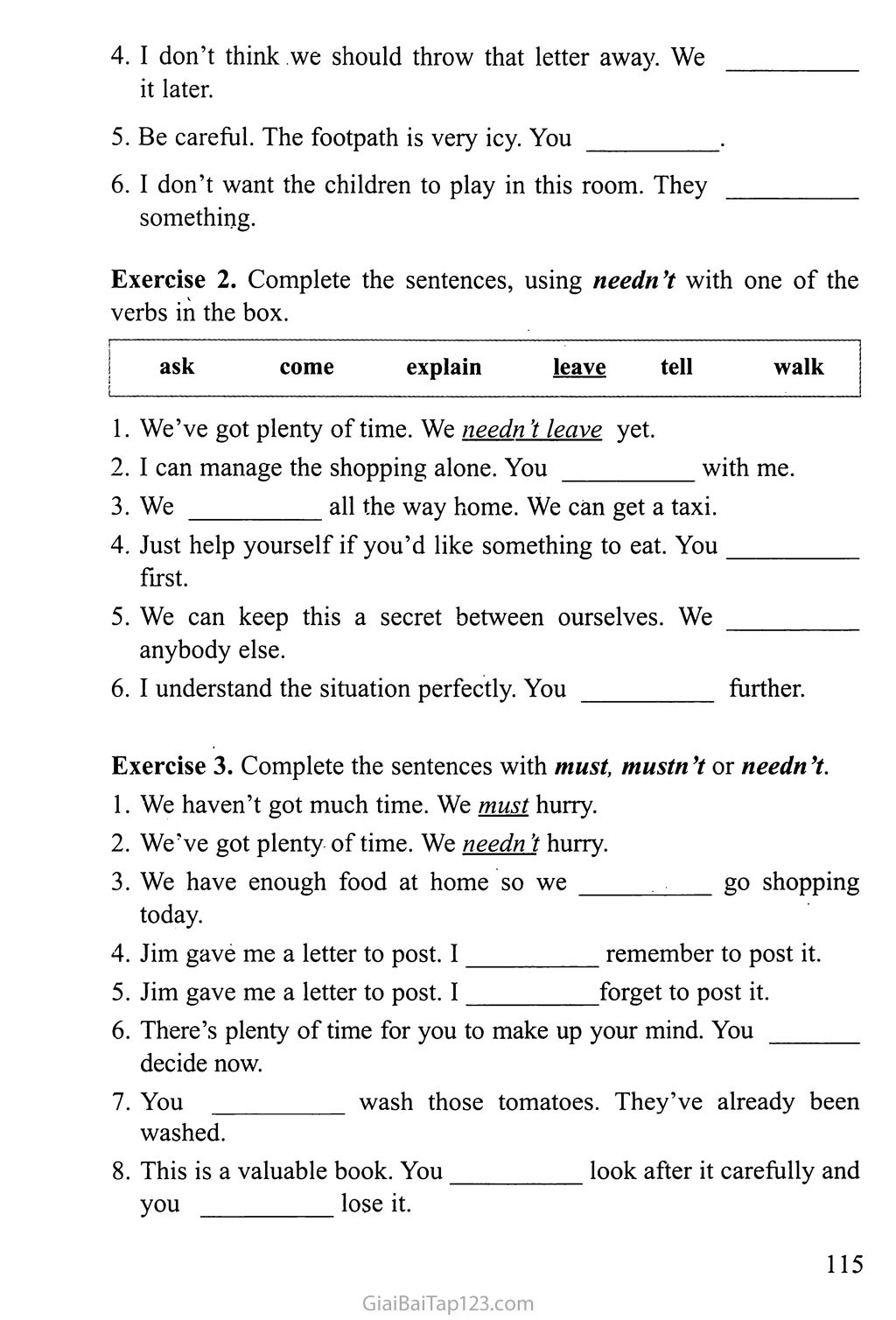SGK Tiếng Anh 12 - Unit 10: ENDANGERED SPECIES
mnìt m ENDANGERED SPECIES A. READING Before you read Work in pairs. Look at the pictures and answer the questions. Which of the animals and insects below can be found in Vietnam? Which of them is/are in danger of becoming extinct? b) rhinoceros c) monkey d) elephant e) leopard a) tortoise f) frog g) mosquito h) parrot Read the text then do the tasks that follow. Endangered species are plant and animal species which are in danger of extinction. Over 8,300 plant species and 7,200 animal species around the globe are threatened with extinction, and many thousands more become extinct each year before biologists can identify them. The primary causes of species extinction are habitat destruction, commercial exploitation and pollution. The drainage of wetlands, cutting of forests, urbanization and road and dam construction have destroyed or seriously damaged natural habitats. Since the 1600s, worldwide commercial exploitation of animals for food and other products has seriously reduced the number of rare species. Toxic chemicals in the air and land, contaminated water and increased water temperatures have also driven many species to the verge of extinction. Plant and animal extinction leads to a loss of biodiversity. Maintaining biodiversity is important for US in many ways. For example, humans depend on species diversity to have food, clean air and water, and fertile soil for agriculture. In addition, we benefit greatly from the many medicines and other products that biodiversity provides. Different conservation efforts have been made in order to save endangered species. The Red List - a global list of endangered and vulnerable animal species - has been introduced to raise people's awareness of conservation needs. Governments have enacted laws to protect wildlife from commercial trade and overhunting. A number of wildlife habitat reserves have been established so that a wide range of endangered species can have a chance to survive and develop. Kễ The number of species around the globe threatened with extinction is over . A. 7,200 B. 8,300 c. 1,600 D. 15,000 Which of the following is NOT mentioned as a primary cause of species extinction? pollution c. habitat destruction natural selection D. overexploitation The Red List is a special book that provides names of animals. vulnerable and endangered hunted Task The nouns in column A all appear in the passage. Match each of them with a suitable definition in column B. A B . . 1. extinction a. the existence of a large number of different kinds of animals and plants which make a balanced environment 2. habitat b. the act of preventing something from being lost, wasted, damaged or destroyed 3. biodiversity c. a situation in which a plant, an animal, a way of life, etc. stops existing 4. conservation d. the natural environment in which a plant or animal lives c. endangered D. extinct C3T Task 2. Choose A, B, c or D to complete the following sentences about the reading passage. The development of wildlife habitat reserves helps . save a large number of endangered species make a list of endangered species c. enact laws to protect wildlife D. develop commercial trade and overhunting The best title for the passage is . Endangered Species and Conservation Measures Endangered Species and their Benefits c. The Global Extinction Crisis D. Endangered Species Extinction: Causes and Conservation Measures [SIT Task 3. Find evidence in the passage to support these statements. Pollution is one of the main causes of species extinction. Species diversity has provided humans with so many essential things. There are a number of ways to help save endangered species. After you read Work in pairs. Summarise the reading passage by writing ONE sentence for each paragraph. B. SPEAKING Kễ3 Task 1 Work in pairs. Ask and answer the following questions. What do you call Gấu Trúc, Tê Giác, Hổ, Voi in English? In which sort of habitats can you find each of these animals? Which of these animals can be kept as a pet or used for food or medicine? Which of them is/are endangered? Kir’ Task Work in pairs. Look at the information about the giant panda, tiger, rhino and elephant, which are endangered animals. Ask and answer questions about them. Example: A: Where do giant pandas live? B: In bamboo forests in the mountains in central and western China. A: What is the population of pandas in the world? Habitat: Bamboo forests in mountains in central and western China. Population: Only about 600 Height: 1.2 to 1.5 m Weight 75 to 160 kg Food: Bamboo Life span: About 20 to 30 years . Reason for decline: Habitat destruction and illegal trading Habitat: Forests, grasslands and swamps in Siberia, Southeast Asia and Southern India. Population: Only about 6,000 Height: 1.4 to 2.8 m Weight: 65 to 300 kg Food: Deer, buffalo, etc... Life span: About 15 to 17 years Reason for decline: ■ Habitat destruction and illegal trading Habitat: Grasslands, tropical and subtropical forests in Africa and southern Asia. Population: About 17,000 Height: 1.2 to 1.8 m Weight: 1,000 to 3,000 kg Food: Grass and plants Life span: About 40 years Reason for decline: Habitat destruction and illegal hunting Habitat: Small areas of India, Sri Lanka, China, and Southeast Asia, and the Sahara desert in Africa. Population: About 700,000 Height: 3 to 4 m Weight: 5,000 to 7,000 kg Food: Grass, bark, root, leaves and fruit Life span: About 60 years Reason for decline: Habitat destruction and illegal hunting B; Only about 600. Work in groups. Take turns to give an oral report on the animals mentioned in Task 2. c. LISTENING Before you listen • Work in pairs. Discuss and choose the best answer A, B or c. You can find gorillas in . A. Europe B. Asia c. Africa The male gorilla may attain a height of m and a weight of about 180 kg. A. 3 B. 1.7 c. 0.8 The life span of a gorilla in the wild is about years. A.30 B. 40 • Listen and repeat. gorilla bared teeth le you liste nest forest rangers c. 50 sociable sub-adult silverback civil war Listen to the passage and choose the best answer A, B, c or D to each question. Which of the following can be a group leader? The biggest and strongest adult male gorilla. A female gorilla. c. The biggest adult female gorilla. D. A grown-up gorilla. With whom do baby gorillas sleep at night? Their sisters. Their mothers, c. Their fathers. D. Their mothers and sisters. Why do hunters kill mountain gorillas? For their skin. For their nests. c. For the trees they live in. D. For food. Which of the following statements is NOT true? Mountain gorillas live in Africa. Scientists study gorillas and show a different picture of mountain gorillas. c. Life for mountain gorillas is peaceful. D. A gorilla sometimes eats worms. What can be learned from the passage? Mountain gorillas are not as dangerous as they look. Mountain gorillas live in groups. c. Mountain gorillas eat mainly plants. D. All of A, B and c are correct. D3T Task 2. Listen again and complete the chart below. General features (1) , gentle, sociable, and (2) Group members the silverback. one or two sub-adult males. (3) Food (4) and worms Place for sleeping nest (5) or (6) Causes of being (7) , hunters killing them for food, endangered (8) After you listen Work in pairs. Summarise the main ideas of the passage, using the information and the answers in Tasks 1 and 2. D WRITING Work in pairs. Suggest possible measures that should be taken to solve the following problems. People do not know much about the need to protect rare and endangered animals. Projects to save endangered animals do not have sufficient funds. The habitats for endangered animals are being seriously damaged and polluted. People who live in or near endangered animals’ habitats have poor living conditions and rely mostly on wildlife products for their livelihood. Some countries do not have laws to protect endangered animals. People keep buying fashionable wildlife products. There are not enough wildlife habitat reserves. Example: People do not know much about the need to protect rare and endangered animals. We should organise different activities to raise people's awareness of the need to protect these animals. Write a paragraph about measures for protecting endangered animals using the ideas discussed in Task 1. Begin your paragraph with: “There are a number of measures that should be taken to protect endangered animals. ” E. LANGUAGE FOCUS Pronunciation: Rhythm Grammar: Modal verbs: may, might, must, mustn’t, needn’t Pronunciation • Practise reading the following sentences, paying attention to the stressed syllables. Tell me the time. Show me the way. He bought some carrots and cabbages. Come for a swim. Look at the clock on the mantelpiece. I think he wants to go tomorrow. It’s not the one I want. Most of them have arrived on the bus. Walk down the path to the end of the canal. I’m going home today for Christmas. A bird in the hand is worth two in the bush. If you don’t have the best, make the best of what you have. Grammar Exercise 1. Complete the sentences, using may/might with one of the verbs in the box. bite break need rain slip wake Take an umbrella with you when you go out. It might rain later. Don’t make too much noise. You the baby up. Be careful of that dog. It you. I don’t think we should throw that letter away. We it later. Be careful. The footpath is very icy. You . I don’t want the children to play in this room. They something. Exercise 2. Complete the sentences, using needn Y with one of the verbs in the box. ask come explain leave tell walk We’ve got plenty of time. We needn’t leave yet. I can manage the shopping alone. You with me. We all the way home. We can get a taxi. Just help yourself if you’d like something to eat. You first. We can keep this a secret between ourselves. We anybody else. I understand the situation perfectly. You further. Exercise 3. Complete the sentences with must, mustn’t or needn’t. We haven’t got much time. We must hurry. We’ve got plenty of time. We needn’t hurry. We have enough food at home so we . . go shopping today. Jim gave me a letter to post. I remember to post it. Jim gave me a letter to post. I forget to post it. There’s plenty of time for you to make up your mind. You decide now. You wash those tomatoes. They’ve already been washed. This is a valuable book. You look after it carefully and you lose it.

